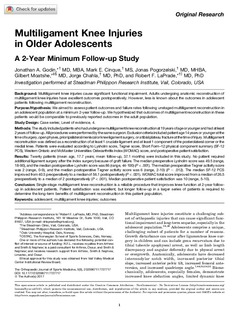| dc.contributor.author | Godin, Jonathan A. | |
| dc.contributor.author | Cinque, Mark E. | |
| dc.contributor.author | Pogorzelski, Jonas | |
| dc.contributor.author | Moatshe, Gilbert | |
| dc.contributor.author | Chahla, Jorge | |
| dc.contributor.author | LaPrade, Robert F. | |
| dc.date.accessioned | 2018-04-20T09:49:42Z | |
| dc.date.available | 2018-04-20T09:49:42Z | |
| dc.date.created | 2018-01-11T09:16:37Z | |
| dc.date.issued | 2017 | |
| dc.identifier.citation | The Orthopaedic Journal of Sports Medicine. 2017, 5, 2325967117727717. | nb_NO |
| dc.identifier.issn | 2325-9671 | |
| dc.identifier.uri | http://hdl.handle.net/11250/2495257 | |
| dc.description | This open-access article is published and distributed under the Creative Commons Attribution - NonCommercial - No Derivatives License (http://creativecommons.org/licenses/by-nc-nd/3.0/), which permits the noncommercial use, distribution, and reproduction of the article in any medium, provided the original author and source are credited. You may not alter, transform, or build upon this article without the permission of the Author(s). For reprints and permission queries, please visit SAGE’s website at http://www.sagepub.com/journalsPermissions.nav. | nb_NO |
| dc.description.abstract | Background: Multiligament knee injuries cause significant functional impairment. Adults undergoing anatomic reconstruction of multiligament knee injuries have excellent outcomes postoperatively. However, less is known about the outcomes in adolescent patients following multiligament reconstruction. Purpose/Hypothesis: We aimed to assess patient outcomes and failure rates following unstaged multiligament reconstruction in an adolescent population at a minimum 2-year follow-up. We hypothesized that outcomes of multiligament reconstruction in these patients would be comparable to previously reported outcomes in the adult population. Study Design: Case series; Level of evidence, 4. Methods: The study included patients who had undergone multiligament knee reconstruction at 19 years of age or younger and had at least 2 years of follow-up. All procedures were performed by the same surgeon. Exclusion criteria included patient age 14 years or younger at the time of surgery, open physes, prior ipsilateral meniscal or knee ligament surgery, or a tibial plateau fracture at the time of injury. Multiligament reconstruction was defined as a reconstruction of at least 1 cruciate ligament and at least 1 component of the posterolateral corner or the medial knee. Patients were evaluated according to Lysholm score, Tegner score, Short Form–12 physical component summary (SF-12 PCS), Western Ontario and McMaster Universities Osteoarthritis Index (WOMAC) score, and postoperative patient satisfaction. Results: Twenty patients (mean age, 17.7 years; mean follow-up, 37.1 months) were included in this study. No patient required additional ligament surgery after the index surgery because of graft failure. The median preoperative Lysholm score was 49.5 (range, 18-90), and the median postoperative Lysholm score was 86 (range, 44-100) (P < .001). The median preoperative Tegner activity score was 2 (range, 0-9), and the median postoperative Tegner activity score was 6 (range, 2-10) (P = .012). The median SF-12 PCS improved from 40.5 preoperatively to a median of 56.1 postoperatively (P < .001). WOMAC total score improved from a median of 26.5 preoperatively to a median of 2 postoperatively (P < .001). Median postoperative patient satisfaction was 10 (range, 5-10). Conclusion: Single-stage multiligament knee reconstruction is a reliable procedure that improves knee function at 2-year follow-up in adolescent patients. Patient satisfaction was excellent, but longer follow-up in a larger series of patients is required to determine the long-term benefits of multiligament reconstruction in this patient population. | nb_NO |
| dc.language.iso | eng | nb_NO |
| dc.subject | adolescent | nb_NO |
| dc.subject | multiligament knee injuries | nb_NO |
| dc.subject | outcomes | nb_NO |
| dc.title | Multiligament Knee Injuries in Older Adolescents: A 2-Year Minimum Follow-up Study | nb_NO |
| dc.type | Journal article | nb_NO |
| dc.type | Peer reviewed | nb_NO |
| dc.description.version | publishedVersion | nb_NO |
| dc.rights.holder | © The Author(s) 2017 | nb_NO |
| dc.source.pagenumber | 2325967117727717 | nb_NO |
| dc.source.volume | 5 | nb_NO |
| dc.source.journal | The Orthopaedic Journal of Sports Medicine | nb_NO |
| dc.source.issue | 9 | nb_NO |
| dc.identifier.doi | 10.1177/2325967117727717 | |
| dc.identifier.cristin | 1540447 | |
| dc.description.localcode | Seksjon for idrettsmedisinske fag / Department of Sport Medicine | nb_NO |
| cristin.unitcode | 150,34,0,0 | |
| cristin.unitname | Seksjon for idrettsmedisinske fag | |
| cristin.ispublished | true | |
| cristin.fulltext | original | |
| cristin.qualitycode | 1 | |
